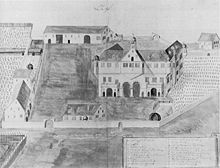Weißenhof (Weinsberg)
The Weißenhof is an estate, first mentioned in 1463, in the area of the town of Weinsberg in the Heilbronn district in the north of Baden-Württemberg . In 1903 a royal sanatorium for the mentally ill was opened on the site adjoining the Weißenhof , which has since then also used the buildings of the courtyard and the areas of the former state domain . The name Weißenhof was increasingly used synonymously for the psychiatric hospital, and after several name changes, the former sanatorium has been officially called Klinikum am Weissenhof since 2002 .
location
The Weißenhof is slightly elevated on the northern side of the confluence of the Eberbachtal in the Sulmtal , between Weinsberg, Gellmersbach , Eberstadt and Erlenbach . The Eberbach or Weißenhofbach, which secured the water supply and drove a mill belonging to the courtyard, flows past only a few dozen meters away.
history
The earliest known mention of the farm, a lease to a shepherd, dates back to 1463. Like the town of Weinsberg and other places in the area, the Hardthof , as it was called at that time, belonged to the Palatinate , which leased it. A mill located in the immediate vicinity of the Eberbach, later mentioned as belonging to the farm, can be found for the first time as müln zu Risach (Reisachmühle) in a document from 1364. Palatinate stock registers from 1465 and 1477 named it after a tenant as Zeinersmühle , which was called in 1528 they then Hardtmühle or Hardthofmühle .
In 1504 the court and its surroundings came to Württemberg as a result of the Landshut War of Succession . In a stock book from 1528, Jörg Weiß is named as the mill leaseholder, and Hans Weiß as the owner of the right of use on the farm. As a result, the name of the court after the Weiss family as Weißenhof prevailed, even if the name Hardthof was still used in an Eberstadt baptismal register in 1692. A Württemberg camp book from 1553 describes the farm as an ensemble of two groups of buildings, each consisting of a house, stables and barns and lent to different families , as well as a sheep house and a wine press .
In 1649, after the Thirty Years' War, the (second) Württemberg-Neuenstadt branch line was established , which also received the Weißenhof. Duke Friedrich von Württemberg-Neuenstadt (1615–1682) handed the court over to his wife Clara Augusta (1632–1700), whom he had married in 1653. After his death in 1682, Clara Augusta moved into the yard as a widow's residence and had two representative buildings built around 1695, a dairy building in the east and a parallel castle in the west, which were connected by a gate in the south . The Weißenhof later came into the possession of the princesses Eleonore Wilhelmine Charlotte and Friederike von Württemberg-Neuenstadt , two of Clara Augusta's granddaughters. With the death of Friederike (1699–1781) it fell back to the main line of Württemberg as a family estate. The construction of the gateway between the dairy and the castle was canceled in 1796.

Towards the end of the 19th century, the Weißenhof was a state domain . Since the four state sanatoriums for the mentally ill in Württemberg (in Zwiefalten , Winnental , Schussenried and Weißenau ) were overcrowded, there was a need to build a fifth institute in the north of the country, today's Klinikum am Weissenhof . The site chosen fell on the Weißenhof, which was only two kilometers from the (opened in 1862) train station in Weinsberg and only six kilometers from Heilbronn . Construction of the new sanatorium began in 1901, and it opened in 1903. The manor was integrated into the institution. The dilapidated Clara Augustas castle was demolished in 1904. In its place, using parts of the castle, a new building was built for the manor and the hospital gardener. In the same year, the Württemberg state acquired the Weißenmühle, which now belonged to a private individual, and converted it into a waterworks for the institute.
Since then, the history of the Weißenhof has been largely identical to that of the sanatorium and the clinic. In 1990, the state of Baden-Württemberg built the state-owned Grabenäcker temporary residence on a state-owned property next to the hospital nursery in the east of the site, which offered space for 261 ethnic Germans in nine barracks . At the end of 2009 the temporary residence, which last had three residents, closed.
Individual evidence
- ↑ Joachim Kinzinger: Transitional residence hall closes the gates . In: Heilbronn voice . December 23, 2009 ( from Stimme.de [accessed June 7, 2010]).
literature
- Simon M. Haag: On the building history of the upper administrative town of Weinsberg. Verlag Nachrichtenblatt der Stadt Weinsberg, Weinsberg 1995, ISBN 3-9802689-8-5 , pp. 216-221
- Ferdinand Ludwig Immanuel Dillenius : Weinsberg, formerly free imperial, now Württemb. Oberamtsstadt. Chronicle of the same . Nitzschke, Stuttgart 1860, pp. 179, 189
- Topographic map 1:25 000 . Sheet 6821 Heilbronn. 3. Edition. Land survey office Baden-Württemberg, Stuttgart 2001, ISBN 3-89021-059-7
Web links
Coordinates: 49 ° 9 ′ 48 ″ N , 9 ° 17 ′ 45 ″ E

